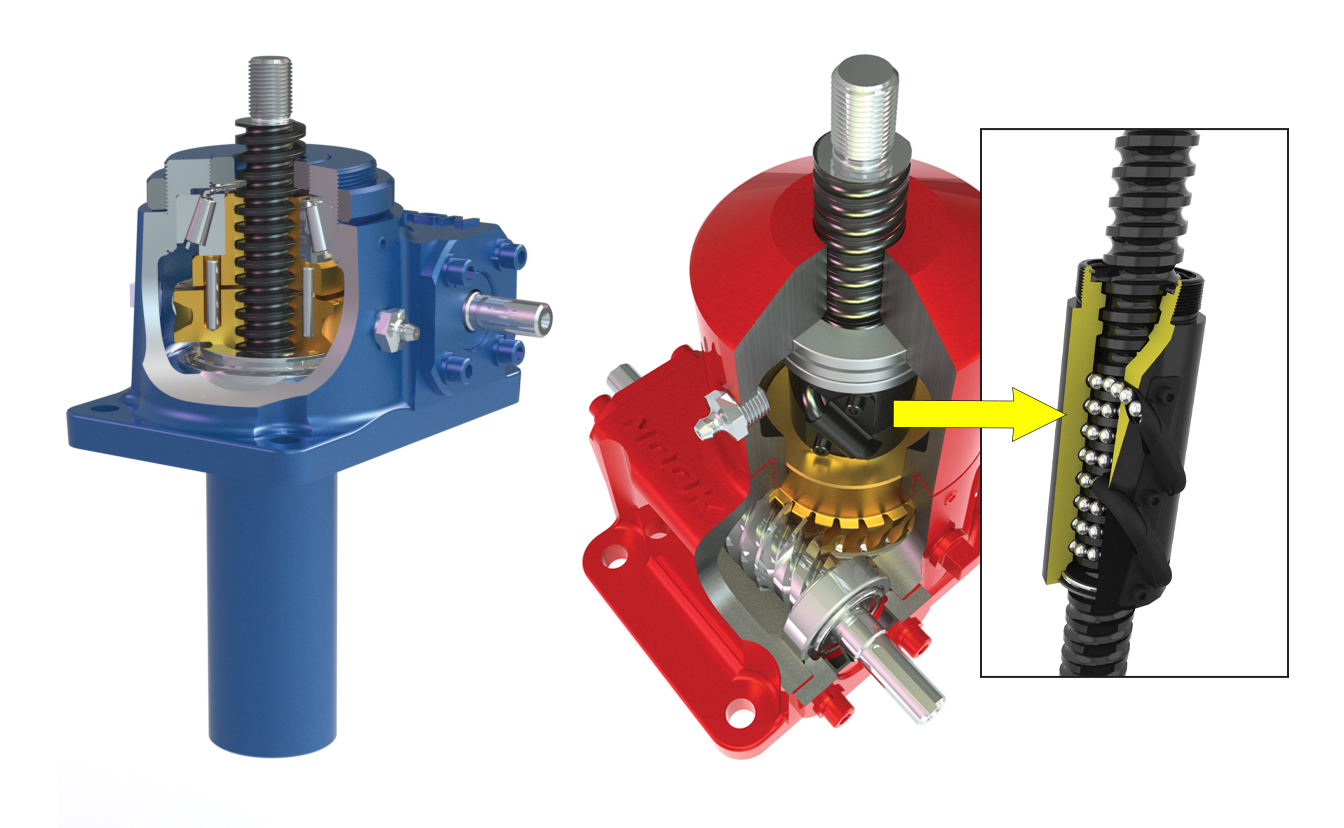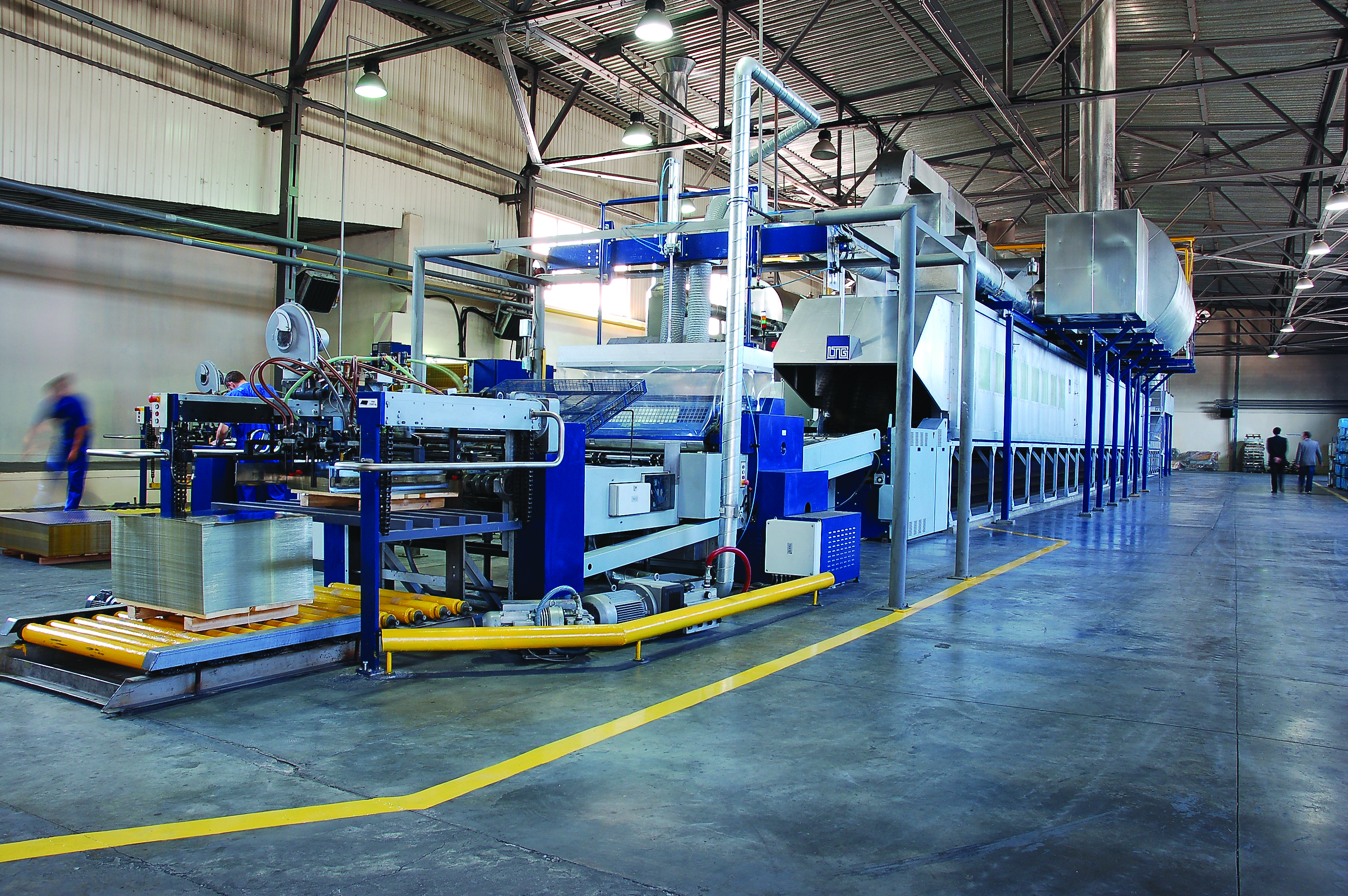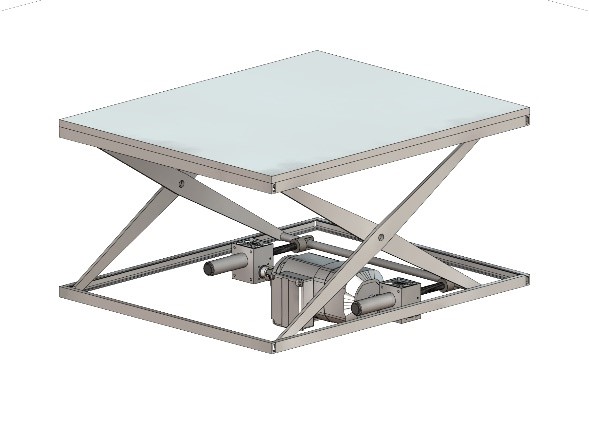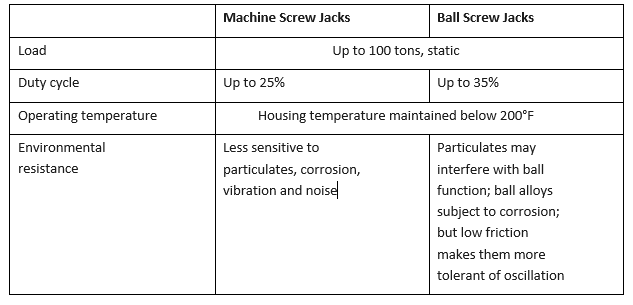When motion system designers want the application flexibility of an electric linear actuator and the heavy lifting, lowering and tilting capability of a hydraulic cylinder, they often turn to screw jacks. Where electric actuators might handle up to two tons, screw jacks can handle more than 100 tons. Their high load capacities come from a worm gear configuration that converts energy from motor or manual input. The two main types of screw jacks are machine screw jacks and ball screw jacks. (Figure 1)

Figure 1. Machine screw jacks (left) use a threaded metal shaft and nut, which is very economical but provides high friction and low efficiency. Ball screw jacks (right) are more expensive, but their use of rolling balls reduces friction and improves efficiency. (Images courtesy of Thomson Industries.)
Machine screw jacks can be provided with a threaded alloy lift shaft attached to a load driven by a bronze nut or ball bearing nut, or the lift shaft can be attached to the drive gear and drive a travel nut that attaches to the load. The relatively simple metal-on-bronze design makes machine screws less expensive but also produces more heat-generating friction, which makes them less desirable for many applications. A ball screw jack also uses a threaded metal lift shaft, but the nut is outfitted with rolling balls that can reduce friction between the screw and nut by nearly 95 percent, offering significant advantages for many applications. To determine whether a machine screw jack or ball screw jack is the right fit for your application, consider the following application parameters early in the design phase:
- required load
- expected duty cycle
- ambient temperature during operation
- presence of particulates or corrosive substances
- tolerance for backdrive
- travel length
- oscillation
- speed
Other design factors that may come into play are the needs for energy efficiency, predictable lifecycle, precision and position control.
Load handling requirements
Motion application developers typically consider screw jacks for loads between ¼ and 100 tons. When machine screw jacks are linked together, even higher loads can be achieved. If the loads are static, for example, to support bridges for extended time periods, machine screw jacks would be most effective as friction would not be a problem. However, for dynamic loads with frequent load cycles, such as moving a conveyor segment between two lines in a production facility, a ball screw configuration would be better as this type of application produces high friction on a machine screw jack.
Potential for shock loading should also be considered. Although vendors seldom recommend either machine screw jacks or ball screw jacks for high shock environments, both can temporarily exceed their rated capacity by about 10% for dynamic loads and 30% for static loads.
Duty cycle
After load conditions, the most important variable to consider is duty cycle, which is the percentage of time that the screw jack will be working. The machine screw jack’s limited ability to dissipate heat constrains the duty cycle. If the jack will be in operation less than roughly 25 percent of the time, which may be necessary to adjust the position of a heavy press, the machine screw jack would be adequate. In many applications where high cyclical load movement demands high duty cycles, often ball screw jacks can be the preferred solution. (Figure 2)

Figure 2. Due to their higher duty cycle, ball screw jacks are an ideal choice for designers looking to produce a fast-paced automated conveyor system. (Image courtesy of Thomson Industries.)
Temperature operating range
Ambient temperature impacts the operating temperature as well. Neither machine screws nor ball screws should operate when the housing temperatures near the worm gear exceed 200°F (93.3°C), and ambient temperature will contribute to this reading. Screw jack manufacturers typically recommend operating at ambient temperatures of around 176°F (80°C) for 25 percent duty cycles and below 122°F (50°C) for more continuous duty.
The hotter the ambient temperature, the greater the need for the low-friction operation of ball screw jacks. Factors that would contribute heat to the operation and thus favor ball screws’ heat-efficient operation include travel length, oscillatory motion, and speed. Designers would not, however, typically use screw jacks in high-speed operations.
Energy consumption
Efficient energy utilization also gives ball screw jacks an advantage in reducing costs. Because of their efficiency, ball screw jacks require less horsepower to operate and thus consume less energy. This feature enables designers to specify a smaller motor as well to meet sustainability objectives. This choice does, however, depend on other application variables, including the duty cycle, environment and speed.
A simple horsepower calculation can be used to determine the proper size of screw jack to use in each application. In addition, measuring the housing temperature can ensure the jack’s usage is not exceeded. If the temperature exceeds the screw jack’s limitations, the designer might still be able to benefit from a more cost-effective machine screw jack but would need to use a larger jack, reduce the motor input speed or use a right-angle reducer. Otherwise, they can use a ball screw jack to take advantage of their higher efficiencies. The high-friction operation of the machine screw within a jack requires about twice as much input torque, so a larger motor would be required as well. In applications in which either multiple machine or ball screw jacks are configured in a system, a single motor could drive all jacks, further improving energy efficiency. A scissor lift, for example, might deploy jacks driving its left and right side with a connecting shaft in between. One motor can drive both jacks. (Figure 3)

Figure 3. The two screw jacks on this scissor lift can work with a single motor. If the duty cycle were less than 25 percent, they could operate with a machine screw jack, which might counter the otherwise higher energy consumption. (Image courtesy of Thomson Industries.)
Tolerance for backdrive
Axial pressure on the lift shaft or travel nut can push it backward, especially if a brake or other holding mechanism in a vertical orientation fails or the system loses power. In such cases, the relative inefficiency and high friction potential of machine screws gives them an advantage over ball screws. Depending on gear ratio and efficiency of lift shaft, machine screw jacks can be considered self-locking.
The high efficiency of ball screws used in vertical configurations can cause them to slide backwards easily if power goes down. For that reason, ball screw jacks must be outfitted with a brake or other holding mechanism, adding cost and complexity.
Presence of particulates, corrosive chemicals, vibration and noise
While ball screws have an advantage in high-duty cycle applications, machine screws have advantages where particulates, toxic chemicals and vibration are present or where excess noise can be an issue.
Machine screws are less sensitive to contamination, making them better for areas in mills or woodworking where particulates might fill the air. Machine screw jacks can be supplied with stainless steel to prevent corrosion in high-moisture environments. Ball screw jacks can utilize various plating techniques to achieve similar benefits.
Machine screw jacks are less sensitive to vibration and are quieter because there are no balls recirculating. This makes them preferable in noise-sensitive environments such as residential and healthcare settings.
Need to predict lifecycle
The engaged frictional thread of the machine screw jack makes it difficult to predict their lifecycle. Ball screw lifecycle, however, can be calculated based on measurable inefficiencies that contribute to fatigue of the ball bearings under a dynamic load. Known as the L10 standard, this calculation estimates the number of revolutions or hours at a given constant speed that 90% of a screw system’s group of bearings will complete or exceed before failure. It is not possible to predict life of machine screws, so if end users need to be able to predict the life of their screw jacks, ball screw jacks are the only option.
Need for precision
Both machine screw jacks and ball screw jacks are highly repeatable. They will have an associated lash between 0.003 to 0.020 inches depending on size. This can be reduced by using a clearance ball nut or a split drive nut for the machine screw jacks.
Need for position control
Both machine screw jacks and ball screw jacks can be motor driven and provided with position control options. The higher the precision required and the higher the duty cycle, however, the more the application would gain from using a ball screw jack.
A tilt station platform supporting a team working on a large airplane wing, for example, might use multiple ball screw jacks synchronized in communication with each other via a CAN bus network. However, if the platform needed adjustment only two or three times per week, a machine screw jack would be adequate. In that latter case, even a machine screw jack equipped with a single, general-purpose motor—using shafting to mechanically link each jack together—might be adequate.
Logical choices
In many applications involving loads of up to 100 tons, screw jacks can provide a very desirable alternative to hydraulic cylinders, but it is important to specify the right type of screw jack. For static loads with duty cycles below 25 percent, a machine screw jack will usually be the most cost effective. For dynamic loads with higher duty cycle, a ball screw jack is necessary.
Within those broad parameters, however, there are many other factors that could affect the decision. Machine screw jacks are more resistant to airborne particulates and corrosive chemicals, are quieter and have minimal backlash. Ball screw jacks, on the other hand, have more predictable lifecycles. Whether the machine screw jack or ball screw jack is right for you will, of course, depend on your application parameters. No matter which screw jack you choose, their increased control, tremendous power, easier installation and environmental friendliness will instill confidence in your motion system design.




